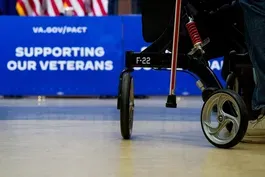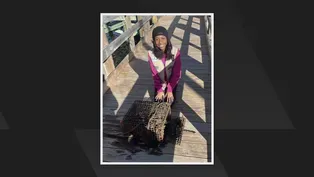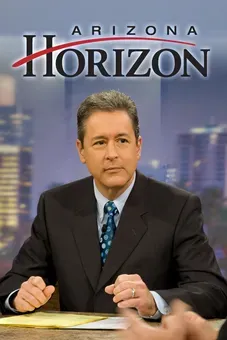
How to reduce the number of teens aging out of foster care
Clip: 6/23/2024 | 5m 7sVideo has Closed Captions
How Arizona aims to reduce the number of teens aging out of foster care
More than 400,000 children in the U.S. are living in foster care. Each year, nearly 20,000 become adults and are left without the support of a guardian or the government. John Yang speaks with Darcy Olsen, CEO of the Center for the Rights of Abused Children, about a pilot project in Arizona designed to help teenagers in foster care find safe and permanent homes before they age out of the system.
Problems with Closed Captions? Closed Captioning Feedback
Problems with Closed Captions? Closed Captioning Feedback
Major corporate funding for the PBS News Hour is provided by BDO, BNSF, Consumer Cellular, American Cruise Lines, and Raymond James. Funding for the PBS NewsHour Weekend is provided by...

How to reduce the number of teens aging out of foster care
Clip: 6/23/2024 | 5m 7sVideo has Closed Captions
More than 400,000 children in the U.S. are living in foster care. Each year, nearly 20,000 become adults and are left without the support of a guardian or the government. John Yang speaks with Darcy Olsen, CEO of the Center for the Rights of Abused Children, about a pilot project in Arizona designed to help teenagers in foster care find safe and permanent homes before they age out of the system.
Problems with Closed Captions? Closed Captioning Feedback
How to Watch PBS News Hour
PBS News Hour is available to stream on pbs.org and the free PBS App, available on iPhone, Apple TV, Android TV, Android smartphones, Amazon Fire TV, Amazon Fire Tablet, Roku, Samsung Smart TV, and Vizio.
Providing Support for PBS.org
Learn Moreabout PBS online sponsorshipJOHN YANG: On any given day in the United States, more than 400,000 children are living in foster care.
And each year nearly 20,000 of them become adults too old for the system that leads them without the support of a guardian or government assistance.
In Arizona lawmakers have passed and sent to the governor a measure creating a pilot program to help teenagers and fun foster care find safe and permanent homes before they age out Darcy Olson is the founder and CEO of the Center for the Rights of Abused children.
Darcy, you're not only an advocate for foster children, but also your foster mother, yourself, children who aged out of the system, what are they facing when they aged out of the system.
DARCY OLSEN, Center for the Rights of Abused Children: But we all know that children should be growing up in families.
And there are so many reasons for that.
And kids who age out are a testament as to why our families are so important.
Most of those kids will disproportionately become homeless, pregnant before they would like to be, they will be unemployed, and they will fill our prisons.
JOHN YANG: And of course, they're beginning their adult lives that must have an impact on their lives further on.
DARCY OLSEN: Well, it's devastating for children.
And, you know, this program that we have passed in Arizona should reduce the number of children aging out of the system by about 30 percent.
So you're talking about 5,000 or 6,000 children a year, teenagers 1617 and 18.
Having families who otherwise wouldn't.
JOHN YANG: Explain this plan in Arizona, how does it work?
How do you prevent these children from aging out?
DARCY OLSEN: Well, the Arizona plan is based on a model from Georgia that was studied and worked very well.
And what we will be doing in Arizona is the system will red flag kids who look like they're at risk of aging out and there are a lot of ways to determine that.
But if you're 16 years old, and you're in the system, there's only a 5 percent chance you're going to get a family.
So we know for sure, it'll be a lot of the older children who have lingered in the foster care system.
Once they're identified, we will build a team around them, psychiatrists, attorneys, private investigators, the private investigators, for instance, will look for any relatives that might not have been identified when the child first came into the system.
And you build this team around the child and you are meeting monthly, you are talking weekly, and you are supercharging your efforts to find a home for this child.
So it's critical that we implement programs like this and really incentivize the government to step up and make it happen for these kids.
JOHN YANG: And the ideal in foster care is that they are eventually adopted or are eventually reunited with family members?
DARCY OLSEN: 100 percent.
When you go into foster care for temporary safety, the goal is hopefully you can go home, you know, they hope that it's a situation that can be remedied.
If it is a situation that can't be, they're going to look for relatives, aunt, uncle, sister wherever they can, if they can't take you, then they're going to look for a foster family.
So I as a foster mother, foster 10 that little ones, and then four of them needed to stay forever because no family or kin came forward.
And that's pretty much what happens nationwide.
So this program will help them will help build a bridge to those families.
JOHN YANG: May ask what happened to those foster children, you were fostering, who said had to stay forever?
DARCY OLSEN: Well, the ones who stayed forever, they're mine.
Now, you know, my car smells like feet and French fries like any other mom's car.
And the other six went on to find almost all two relatives and one took a special placement with a special family.
JOHN YANG: You said that the model for the Arizona program was Georgia, are there other states that have similar programs?
DARCY OLSEN: We're not aware of any states that have been as successful as Georgia in reducing the number aging out or increasing the number of children who get families.
And so we thought this was the best model out there.
Hopefully we can do even better than Georgia learning and you know, standing on their shoulders.
And we believe that there is a home for every child and that it is simply the government's job to build that bridge, build that bridge from these children in need to the loving and Safe Families who would love nothing more than to take them in and give them a great home and family.
JOHN YANG: Are there other states that are looking at programs like this?
Are you pushing for programs like this and other states?
DARCY OLSEN: We're taking this all over the country.
So we hope to see most state legislatures open in January.
So we hope to see many of them and many of their governors introducing this program, JOHN YANG: Darcy Olson of the Center for the rights of abused children.
Thank you very much.
DARCY OLSEN: Thank you so much.
How private firms profit from veterans’ disability claims
Video has Closed Captions
What to know about the private firms illegally profiting from veterans’ disability claims (7m 6s)
Ninth grader helps restore Mississippi’s oyster reefs
Video has Closed Captions
Meet the ninth grader who’s helping restore Mississippi’s oyster reefs (4m 17s)
Why little is known about what causes many miscarriages
Video has Closed Captions
Why little is known about what causes many pregnancies to end in miscarriage (4m 4s)
Providing Support for PBS.org
Learn Moreabout PBS online sponsorshipSupport for PBS provided by:
Major corporate funding for the PBS News Hour is provided by BDO, BNSF, Consumer Cellular, American Cruise Lines, and Raymond James. Funding for the PBS NewsHour Weekend is provided by...














